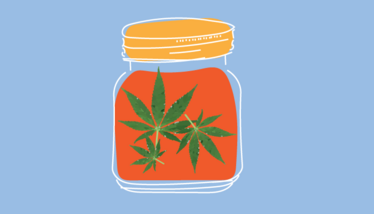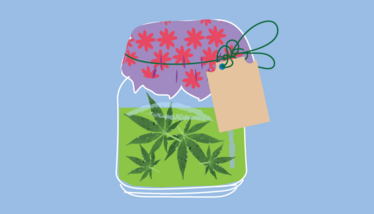
Dead on Arrival?
Why guaranteed product shelf life may be the most critical component of cannabis research
sponsored by Orion GMP
There are plenty of anecdotes from dissatisfied patients who fail to find the same relief from one batch of cannabis to the next. There are likely even more stories of adult use consumers questioning the provenance or identity of their purchase. But when it comes to research – where cannabis origin and processing should (at least in theory) be guaranteed – have we placed enough emphasis on controlling what happens from the harvest to the lab? Here, we explore how product stability is affecting patients, the industry – and, in particular, cannabis scientists who are keen to eliminate all sources of potential variation to publish the best, most reproducible research.
(Good) Practice Makes Perfect
By Andrew Samann, CEO of Orion GMP Solutions
Cannabis is a living organism with complex systems designed to protect it against the environment and pathogens. When it is cut, preservation requires careful handling. Preservation directly relates to quality (see box “GMP 101”), which is dependent on some basic facts. How much time has passed between cutting and storing? How quickly was the cannabis processed? How was it dried? In short, the key to quality cannabis is adequate preservation–and that demands water activity testing.
When it comes to cannabis drying, some prefer to hang dry, others prefer to cut the buds down and dry on trays; in any scenario, measuring the rate of evaporation is critical – and this can only really be measured via water activity (the relative humidity immediately adjacent to the product vs the total moisture in the plant). Indeed, the impact of the drying process can only be understood by precisely measuring water activity in any drying case (from fastest or slowest) and relating drying rate to product quality. Product quality may be assessed by water activity, as well as, shape, odor, bud size, color, et al. These critical quality attributes (CQAs) determine if a cannabis sample is well preserved and of high quality. Optimizing CQAs for the drying process provides growers the guidelines they need to sustain the quality of their flower.
GMP 101
I am often asked: What is the value of good manufacturing practice (GMP)? A better question is: What is the cost of quality? How much does a recall or regulatory infraction cost? Then you consider the potential contracts lost as a result of any breach, the cost of quality becomes even more significant. You can put a number on the financial burden of not meeting FDA requirements, but what about the impact of a spoiled scientific sample? It’s certainly less tangible but no less important for the customers of those products –researchers. GMP essentially improves product quality through the naming of specifications. What goes into the product? Is it safe? Is the facility clean? Does it meet certain standards? Are staff sufficiently trained? Each and every aspect contributes towards a quality management system. But when it comes to cannabis flower the ultimate control points arguably happen post-harvest.
Preserve and protect
So why is preservation such a big deal? In Canada, as in many places around the world, more cannabis is grown than consumed. Overproduction results in surplus. This aged inventory may not be safe to consume, which results in companies having no choice but to destroy product. As an industry, we still haven’t worked out the critical control point between packaging and long-term shelf life – but it’s time we do so.
Recent global circumstances that caused retail closures and shipping delays illustrate why we must protect product throughout the supply chain. Contrary to past belief, we have little control over how long cannabis will sit on the dock or the shelf. There are no cannabis-specific guidelines for packaging and humidity control. Cannabis professionals, therefore, implement GMPs by interpreting scientific literature then relating it to the specific needs of their cultivars and extracts. Understanding how water relates to that is more fundamental than people understand.
Currently, Orion GMP is overseeing a stability study assessing the performance of salt solution-based humidity control sachets, which are designed to protect active ingredients in cannabis flower from evaporation and degradation. These saturated salt solution sachets are engineered to create a microclimate with the optimum level of humidity for sample preservation. The goal of the study is to establish cannabis shelf life guidelines for various packaging component systems.
For pharmaceuticals, there are two main types of containers – impermeable and permeable. This stability study will go beyond those, using multiple packaging types, including impermeable, permeable and experimental containers as well as a control group. We will measure the performance of the sachets in multiple configurations of a packaging system to establish legitimate shelf-life claims.
Not only will we ascertain stability immediately after the flower is dried and cured, but how it responds over time – particularly in fluctuating environments. That means studying flower with and without a sachet through every step of the supply chain –from harvest to the point of delivery, including international distribution.
Though there are plenty of people working on stability for their own products, this will be the first time a packaging component system has been studied outside of a single company or brand. How exciting would it be to offer a universal solution, where a single sachet could offer a defined, extended shelf life to anyone, anywhere? We don’t have the answer yet, but we will in time.
The cost is too great not to.

Save the Terps – Reprise!
An interview with Cindy S. Orser, CSO at Clip Labs
Why are terpenes so important in our understanding of the cannabis plant?
Terpenes represent a large, diverse category of pharmacologically active chemicals made by animals, insects, microbes, and plants, including cannabis. Terpenes provide the distinguishing bouquet of the cannabis flower and can be used to phylogenetically classify cannabis strains. In fact, terpenes can make up three to five percent of the dry mass of cannabis flower.
Terpenes interact with receptors in our bodies to elicit responses, including at the neuroexcitatory dopaminergic and GABAergic receptors; beta-caryophyllene actually binds to the same CB1 receptor as THC (you may not know that cannabinoids are technically terpenoids – modified terpenes). Terpenes have shown many of the same properties associated with cannabinoids, including, analgesic, anxiolytic, anticancer, neuroprotective, and more. Up until recently, everyone has been fixated solely on THC content. Terpenes were not only being lost during processing but also in the discussion! It’s time for this to change.
How does the supply chain impact the quality of flower and therefore terpenes?
Terpenes are volatile, so their preservation in cannabis flower post-harvest can be problematic. If the environmental conditions under which the cannabis flower is cured and stored are not optimal, terpenes will be lost, which changes the original terpenoid profile of that particular lot of cannabis flower. The extraction process can further reduce or eliminate terpenes.
How can we make sure research materials are kept in the best possible conditions – and why should we care?
Put simply, cannabis research materials should be harvested, dried, and cured following a standard operating procedure (SOP). SOPs should also be followed after curing – cannabis flower should be stored under constant temperature and humidity conditions. Stability of active ingredient(s) in any test material is essential. Furthermore, any active ingredient that is being studied in vitro or at the sub-clinical/ clinical level must be proven to remain stable for the duration of the study at a minimum but hopefully for much longer.
What are the critical control points in cannabis research that are being overlooked?
The number one priority has been to get the DEA to allow experienced cannabis growers to produce flower destined for research, following SOPs. We have seen progress, however; in 2021, the DEA offered some flexibility on who can grow cannabis flower for research purposes. Labs such as Biopharmaceutical Research Company and other federally compliant organizations are working hard to ensure investigators are getting the best possible materials.

A Clever Primer on Quality Control
A rapid-fire interview with Andres Fajardo, President of Clever Leaves
How would accurate shelf-life claims of cannabis inflorescence benefit the industry as a whole?
Perhaps the biggest impact would be on patients and researchers, who would both have a better understanding of a critical aspect of product quality, which affects both safety and efficacy.
How critical is product stability to investigative outcomes?
The simple reality is that product characteristics can change over time. Characteristics are driven by chemical components, which can be subject to degradation. The loss of a key characteristic could result in a failure to deliver the desired effect (efficacy) or even pose a risk to the health of patients (safety). From a research perspective (for the reasons mentioned above), it is not possible to enter into an informed decision-making process without product stability knowledge. After all, instability of the product directly affects the reproducibility of the results, which harms the investigative process or the credibility of the outcome – or both.
How can we make sure research materials are kept in the best possible condition?
As with medicines destined for patients, packaging should be considered a fundamental part of product development as it guarantees the stability of research materials. An important (but often overlooked) aspect of product development is the consideration of conditions throughout the whole chain. Good packaging along with modern technology, such as conditions tracking, supports this goal. In short, the best way to keep any material in its optimal condition is by defining the storage and handling conditions – and these are related to the production process and the packaging.












